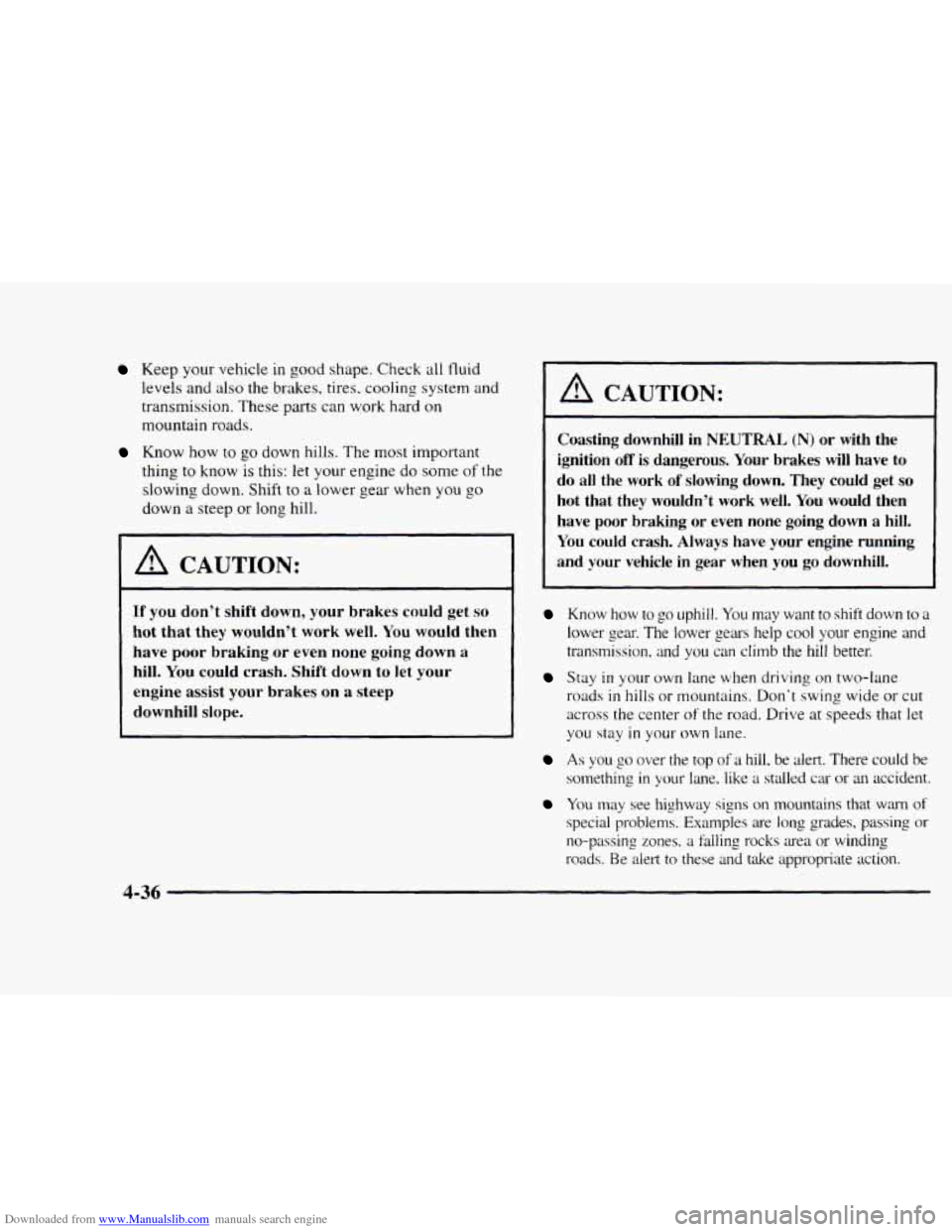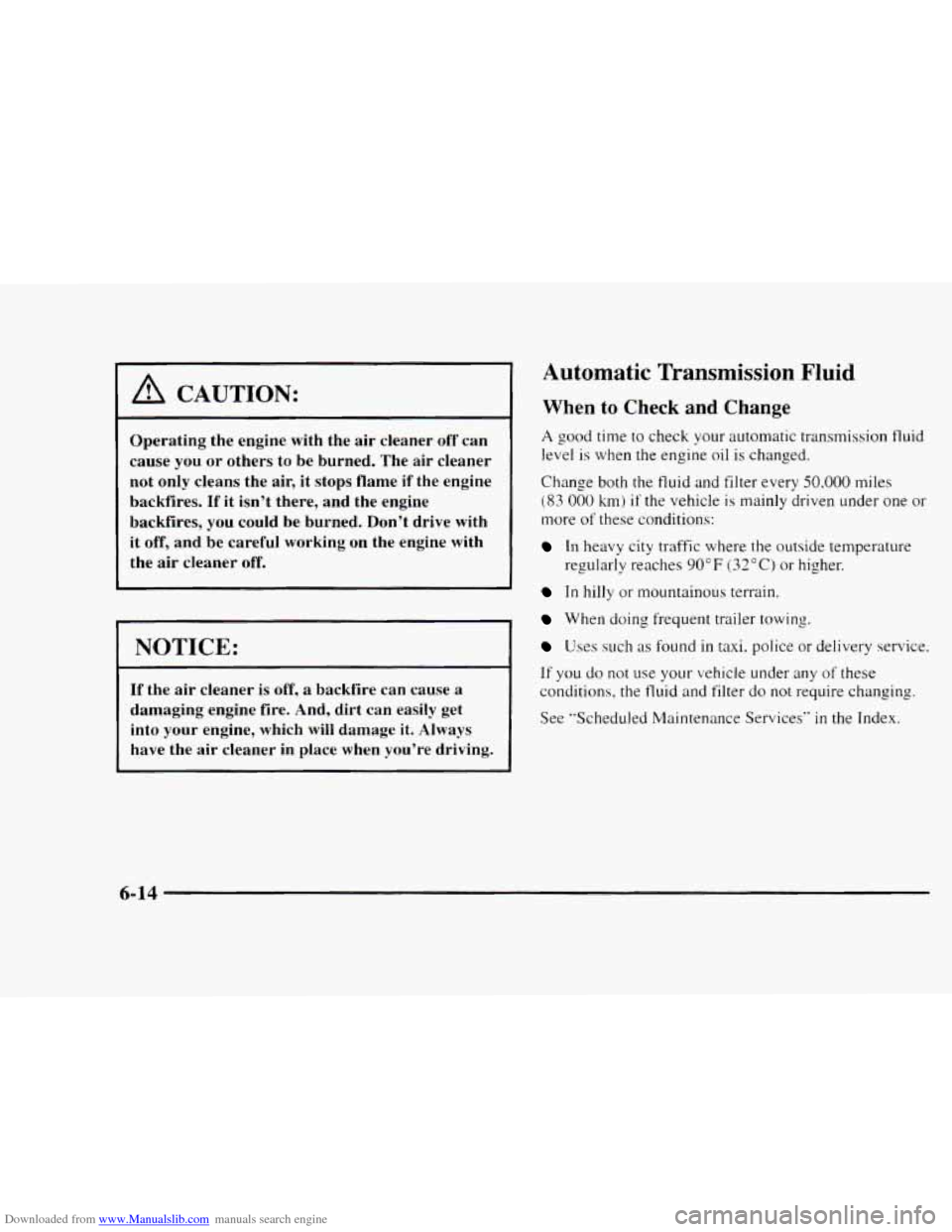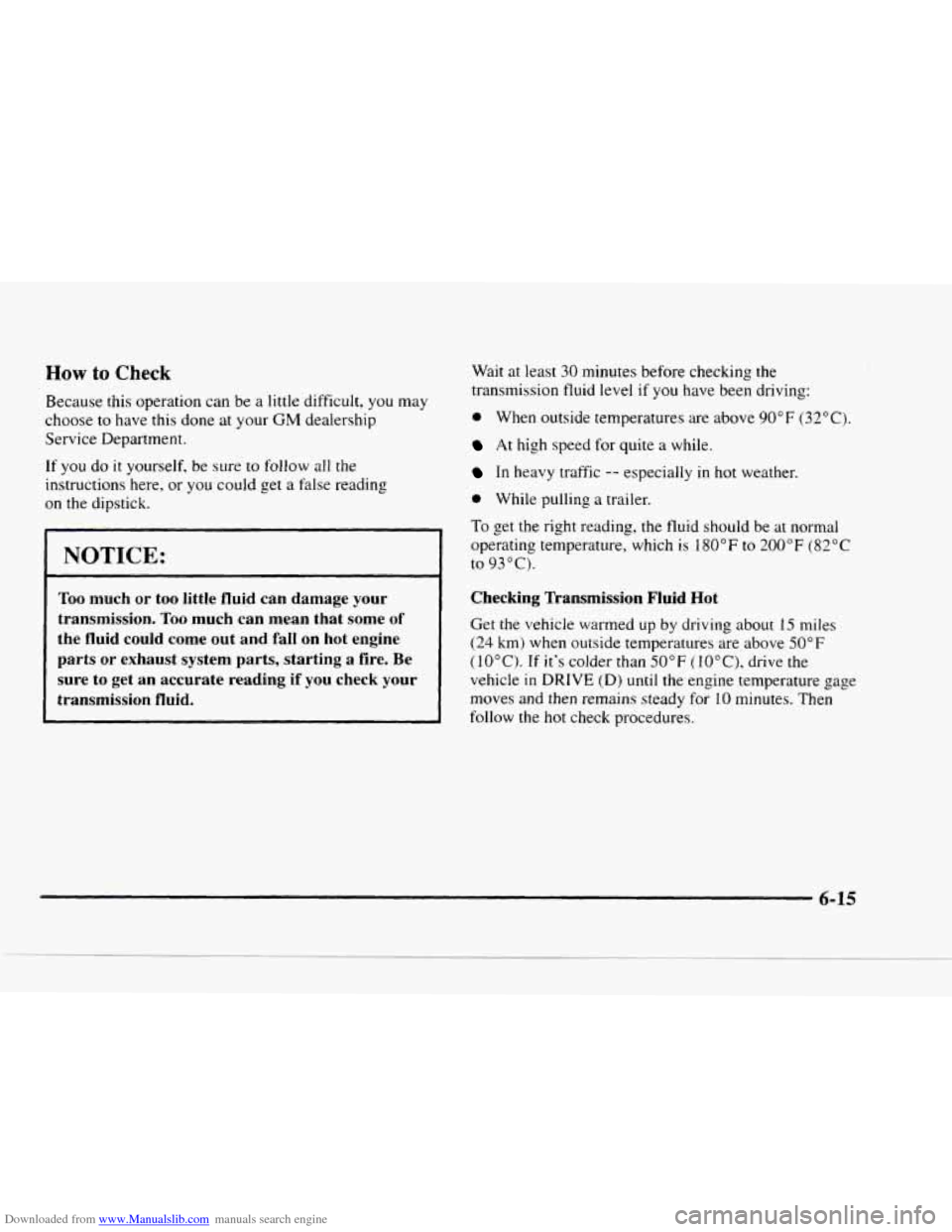Page 197 of 402

Downloaded from www.Manualslib.com manuals search engine Keep your vehicle in good shape. Check all fluid
levels and
also the brakes, tires. cooling system and
transmission. These parts can work hard
on
mountain roads.
Know how to go down hills. The most important
thing
to know is this: let your engine do some of the
slowing down. Shift
to a lower gear when you go
down a steep or long hill.
A CAUTION:
If you don’t shift down, your brakes could get so
hot that they wouldn’t work well. You would then
have poor braking or even none going down a
hill.
You could crash. Shift down to let your
engine assist your brakes on a steep
downhill slope.
I A CAUTION:
Coasting downhill in NEUTRAL (N) or with the
ignition
off is dangerous. Your brakes will have to
do all the work
of slowing down. They could get so
hot that they wouldn’t work well. You would then
have poor braking or even none going down a hill.
You could crash. Always have your engine running
and your vehicle in gear when you go downhill.
Know how to go uphill. You may want to shift down to a
lower gear. The lower gears help cool your engine and
transmission. and you can climb the
hill better.
Stay in your own lane when driving on two-lane
roads
in hills or mountains. Don‘t swing wide or cut
across the center
of the road. Drive at speeds that let
you stay in your own lane.
As you go over the top of a hill, be alert. There could be
something
in your lane. like a. stalled car or an accident.
You may see hishway signs on mountains that warn of
special problems. Examples are long grades, passing or
no-passing zones.
a falling rocks area or winding
roads.
Be alert to these and take appropriate action.
4-36
Page 215 of 402
Downloaded from www.Manualslib.com manuals search engine When You Are Ready to Leave After
Parking
on a Hill
1. Apply your regular brakes and hold the pedal down
whiie you:
Start your engine:
Shift into a gear: and
Release the parking brake.
3,. Let up on the brake pedal.
3. Drive slowly until the trailer is clear of the chocks.
4. Stop and have someone pick up and store the chocks.
Maintenance When Trailer Towing
Your vehicle will need service more often when you’re
pulling
a trailer. See the Maintenance Schedule for more
on this. Things that are especially important in trailer
operation are automatic transmission fluid (don’t
overfill), engine
oil, axle lubricant, belt. cooling system
and brake adjustment. Each
of these is covered in this
manual. and
the Index will help you find them quickly.
If you’re trailering, it‘s a good idea to review these
sections before you start your
trip.
Check periodically to see that all hitch nuts and bolts
are tight.
4-54
Page 256 of 402

Downloaded from www.Manualslib.com manuals search engine Section 6 Service and Appearance Care
Here you will find information about the care of your vehicle. This section begins with service and fuel information,
and then
it shows how to check important fluid and lubricant levels. There is also technical information about your
vehicle, and a part devoted
to its appearance care.
6-3
6-4
6-5
6-6
6-9 6-
13
6- 14
6-18
6- 19
6-
20
6-2 1
6-23
6-26
6-26
6-26 6-27
Fuel
Fuels in Foreign Countries
Filling Your Tank
Checking Things Under the Hood
Engine Oil
Air Cleaner
Automatic Transmission Fluid
Manual Transmission Fluid
Hydraulic Clutch
Rear Axle
Four-wheel Drive and All-Wheel Drive
Engine Coolant Radiator Pressure Cap
Thermostat Power Steering Fluid
Windshield Washer Fluid 6-28
6-32
6-3 3 6-3 8
6-40 6-49
6-49
6-52
6-54
6-5
7
6-5 8
6-58
6-58
6-62
6-63
6-64
Brakes
Battery
Bulb Replacement
Windshield Wiper Blade Replacement
Tires
Appearance Care
Cleaning the Inside
of Your Vehicle
Care
of Safety Belts
Cleaning the Outside of Your Vehicle
Appearance Care Materials Chart
Vehicle Identification Number
(VIN)
Service Parts Identification Label
Electrical System
Replacement Bulbs
Capacities and Specifications
Air Conditioning Refrigerants
Page 263 of 402
Downloaded from www.Manualslib.com manuals search engine When you lift the hood. you'll see these items:
B -- ."*f . ..
A. Battery
B. Coolant Recovery Tank
C. Engine Oil Dipstick
*
C
D. Transmission Dipstick
E. Engine Oil Fill
F. Power Steering Reservoir
G. Brake Master Cylinder
H. Air Cleaner
I. Windshield Washer Fluid
6-8
Page 269 of 402

Downloaded from www.Manualslib.com manuals search engine A CAUTION:
Operating the engine with the air cleaner off can
cause you or others to be burned. The air cleaner
not only cleans the
air, it stops flame if the engine
backfires.
If it isn’t there, and the engine
backfires, you could be burned. Don’t drive with
it
off, and be careful working on the engine with
the air cleaner
off.
NOTICE:
If the air cleaner is off, a backfire can cause a
damaging engine fire. And, dirt can easily get
into your engine, which will damage
it. Always
have the air cleaner in place when you’re driving.
Automatic Transmission Fluid
When to Check and Change
A good time to check your automatic transmission fluid
level is when the engine oil is changed.
Change both the fluid and filter every
50,000 miles
(53 000 km) if the vehicle is mainly driven under one or
more
of these conditions:
In heavy city traffic where the outside temperature
regularly reaches
90°F (32°C) or higher.
In hilly or mountainous terrain.
When doing frequent trailer towing.
Uses such as found in taxi. police or delivery service.
If you do not use your vehicle under any of these
conditions, the fluid and filter
do not require changing.
See “Scheduled Maintenance Services”
in the Index.
6-14
Page 270 of 402

Downloaded from www.Manualslib.com manuals search engine How to Check
Because this operation can be a little difficult, you may
choose
to have this done at your GM dealership
Service Department.
If
you do it yourself, be sure to follow all the
instructions here, or
you could get a false reading
on
the dipstick.
NOTICE:
Too much or too little fluid can damage your
transmission.
Too much can mean that some of
~ the fluid could come out and fall on hot engine
parts
or exhaust system parts, starting a fire. Be
' sure to get an accurate reading if you check your
transmission fluid.
Wait at least 30 minutes before checking the
transmission
fluid level if you have been driving:
0 When outside temperatures are above 90°F (32°C).
At high speed for quite a while.
In heavy traffic -- especially in hot weather.
0 While pulling a trailer.
To get the right reading, the fluid should be at normal
operating temperature, which is
180°F to 200°F (83OC
to 93°C).
Checking Transmission Fluid Hot
Get the vehicle warmed up by driving about 15 miles
(24 km) when outside temperatures are above 50°F
(IOOC). If it's colder than 50°F (IOOC), drive the
vehicle
in DRIVE (D) until the engine temperature gage
moves and then remains steady for
10 minutes. Then
follow the hot check procedures.
6-15
Page 271 of 402
Downloaded from www.Manualslib.com manuals search engine Checking Transmission Fluid Cold
A cold check is made after the vehicle has been sitting
for eight hours or more with
the engine off and is used
only as a reference. Let the engine run at idle for five
minutes
if outside temperatures are 50°F ( 10°C) or
more.
If it's colder than 50°F (IOOC), you may have to
idle the engine longer. Should the fluid level be low
during
a cold check. you mrrst perform a hot check
before adding fluid. This
will give you a more accurate
reading
of the fluid level.
Checking the Fluid Hot or Cold
0 Park your \.tthicle on a level place. Keep the
engine
running.
0 With the parking brake applied. place the shift lever
in PARK (P).
Then, without shutting off the engine, follow these steps:
1. Flip the handle up and then pull out the dipstick and
wipe
it with a clean rag or paper towel.
2. Push it back in all the way, wait three seconds and
then
p~dl it back out again.
6-16
Page 272 of 402

Downloaded from www.Manualslib.com manuals search engine How to Add Fluid
Refer to the Maintenance Schedule to determine what
kind
of transmission fluid to use. See “Recommended
Fluids and Lubricants”
in the Index.
Add fluid
only after checking the transmission fluid
HOT. (A COLD check is used only as a reference.) If
the fluid level is low, add only enough of the proper
fluid
to bring the level up to the HOT area for a hot
check. it doesn’t take much fluid, generally less than
one pint
(0.5 L). Don’t overfill.
3. Check both sides of the dipstick, and read the lower
level. The fluid level must be in the
COLD area for a
cold check
or in the HOT area or cross-hatched area
for
a hot check.
4. If the fluid level is in the acceptable range, push the
dipstick back in all the way; then flip the handle
down
to lock the dipstick in place.
I NOTICE:
~ ~~ ~
We recommend you use only fluid labeled
DEXRON@-111, because fluid with that label is
made especially for your automatic transmission.
Damage caused by fluid other than
DEXRON-111
is not covered by your new vehicle warranty.
After adding fluid, recheck the fluid level as
described under “How to Check.”
When the correct fluid level is obtained, push the
dipstick back in all the
way; then flip the handle
down
to lock the dipstick in place.
6-17